Owls in Colorado: Colorado is home to a variety of wildlife, including fascinating owl species. Also, These birds are active at night and live in different places, like forests and grasslands. In this article, I’ll tell you about Colorado’s owl species, their special features, where they build nests, and what they eat. Moreover, We’ll also talk about how people are working to protect their homes. From the small Northern Pygmy Owl to the impressive Great Horned Owl, let’s explore the amazing world of Colorado’s owls!
Here we’ll learn about 10 different Owls in Colorado
1. Eastern Screech-Owl
- Scientific name: Megascops asio
- Life span: 8 to 10 years
- Size: 16 to 25 cm
- Weight: 121 to 244 g
- Wingspan: 46 to 61 cm
- Status: Least Concern
The Eastern Screech-Owl is a fascinating bird found in different parts of Eastern North America, including Mexico. What’s cool about it? Well, it’s not bothered by people and can even live happily in cities!
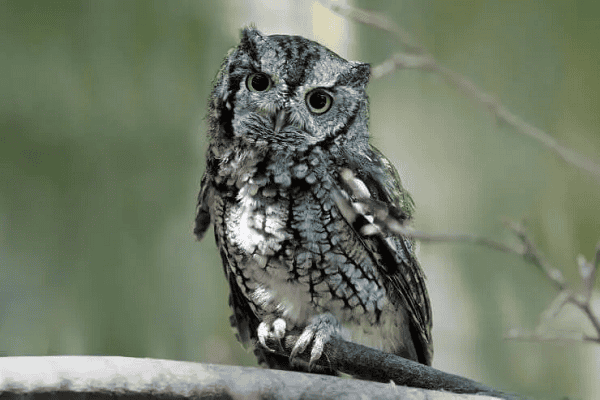
Now, let’s talk about its colors. Some of these owls have reddish feathers in the south, while others have grayish tones up north. Scientists think these colors match the forests where they live.
When it’s time to find a partner, Eastern Screech-Owls get serious. Also, They do special bonding rituals during courtship to create a lifelong connection. After mating, they build their nests in dark, hollow tree trunks in dense forests.
Here’s an interesting twist: While most of these owls stay faithful to one mate, some males play the field. They might mate with different females during the same breeding season. That can lead to drama—like the first female getting kicked out so the male can start a new family.
Now, let’s talk about food. Eastern screech owls are adaptable hunters. Also, They go after small mammals like voles, mice, shrews, and rats. But when those are scarce, they snack on insects like beetles, moths, spiders, worms, and snails. Sometimes, they even munch on reptiles, birds, and amphibians. And guess what? They’re night owls (literally)! They use their sharp hearing to find prey.
2. Great Horned Owl
- Scientific name: Bubo virginianus
- Life span: 25 – 50 years
- Size: 43 to 64 cm
- Weight: 1200-1600 g
- Wingspan: 91-153 cm
- Status: Least Concern
The Great Horned Owl is a big bird with brown spots on its feathers. It can live in many places like deserts, swamps, grassy areas, cities, and woods. It’s active at night and can hide well in its surroundings.
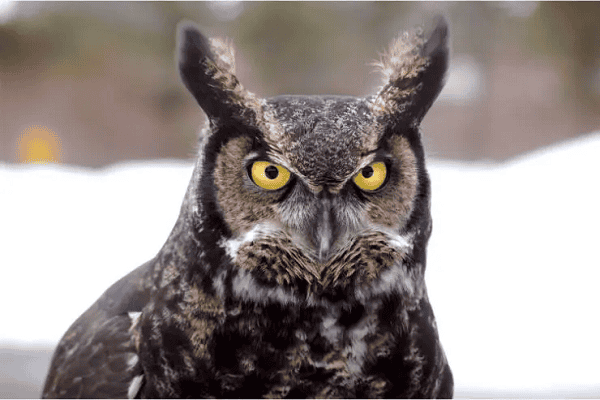
These owls live not just in North America but also far away in Brazil. They have special feathers on their heads that look like horns, called plumicorns. These might help them show off or talk to other owls, but we’re not sure why they have them.
In North America, these owls start looking for a mate early in the year, around January. The males owls do fancy flying and make noise to impress the female owls and pick a good place for their nest. They don’t make their own nests; they use old ones from other big birds like eagles or hawks. They can nest in many places, from caves and cliffs to even cacti!
Great Horned Owls eat many different things and are good at hunting. In Colorado, they eat small animals like voles, mice, and rabbits, but their food changes with the seasons. They also eat birds, lizards, frogs, and bugs. They hunt mostly at night using their sharp claws and beak.
3. American Barn Owl
- Scientific name: Tyto furcata
- Life span: 10 years
- Size: 34-38 cm
- Weight: 400-600 g
- Wingspan: 29 to 36 cm
- Status: Least Concern
The American Barn Owl is a special bird that comes out at night. During the day, it hides in trees or tree trunks.
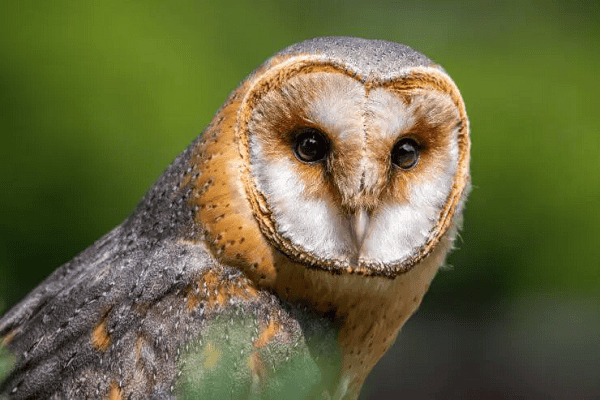
People have told stories about the Barn Owl, thinking it’s magical or from another world.
Between March and June, these owls find a partner for life. Furthermore, The male owl looks for a good place to build a nest, like a tree hole or a cliff. He flies around energetically to claim his territory. Then, he shows off by chasing and sweeping around the female owl.
4. Barred Owl
- Scientific name: Strix varia
- Life span: 8 years
- Size: 40-63 cm
- Weight: 610-1,150 g
- Wingspan: 96-125 cm
- Status: Least Concern
Scientists studied 158 Barred Owls and found out that these owls like to stay close to home, usually within 6 miles. You can see them a lot in the eastern part of the USA and the south of Canada.
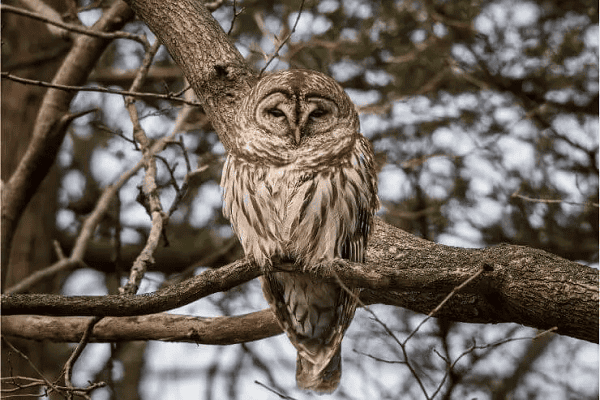
Barred Owls have brownish-grey feathers with dark stripes on their bellies. They are like American Barn Owls because they pick one partner and stay with them for life. The male owl shows off his wings to the female to win her over, which usually happens in February. They make their homes in the holes of trees in thick forests.
Also, These owls eat mostly small animals like mice and voles, and sometimes birds, reptiles, and bugs. They might also eat bigger animals like rabbits and squirrels if they can catch them. They have really good hearing, which helps them find food near rivers in the forest and wetlands. Sometimes, they’ll even eat animals that are already dead.
There are about 3 million Barred Owls in the world, and they’re doing okay in North America. They’re not in danger of disappearing soon, but they still have to deal with problems like their food getting poisoned and their forest homes being destroyed or disturbed.
5. Short-eared Owl
- Scientific name: Asio flammeus
- Life span: 12 years
- Size: 34-43 cm
- Weight: 206-475 g
- Wingspan: 85-110 cm
- Status: Least Concern
The Short-Eared Owl is a bird that lives in many places around the world. It has a small black beak, a brown body with spots, and wings and tail with brown stripes.
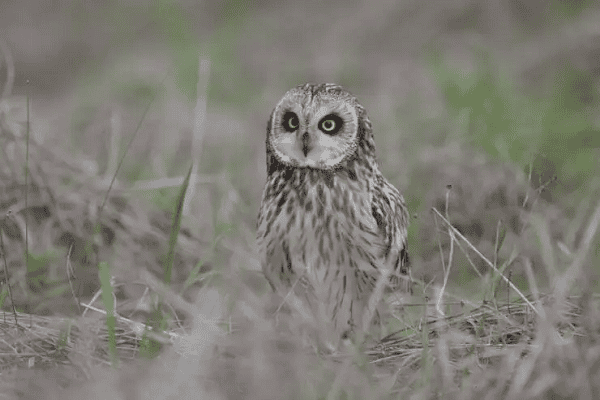
What’s special about the Short-Eared Owl is that it hunts during the daytime, not at night like most other owls.
Also, These owls are found all over the world in different places like grasslands and cold, flat lands. They start looking for a mate in March, and unlike other owls, they live with their mates for just one season and stay in groups. They build their nests on the ground where there’s not much tall grass or plants.
Short-Eared Owls eat small animals like voles, shrews, and rodents, and sometimes they eat reptiles, frogs, bugs, and small birds. They hunt by flying close to the ground in open places during the day.
6. Long-eared Owl
- Scientific name: Asio otus
- Life span: 10 to 27 years
- Size: 31-40 cm
- Weight: 160-435 g
- Wingspan: 86-102 cm
- Status: Least Concern
The Long-Eared Owl is really good at hiding in pine trees because its brown and black feathers look like the trees. These owls are found all over the world, and they’re known for their spooky sounds that can travel really far in the forest.
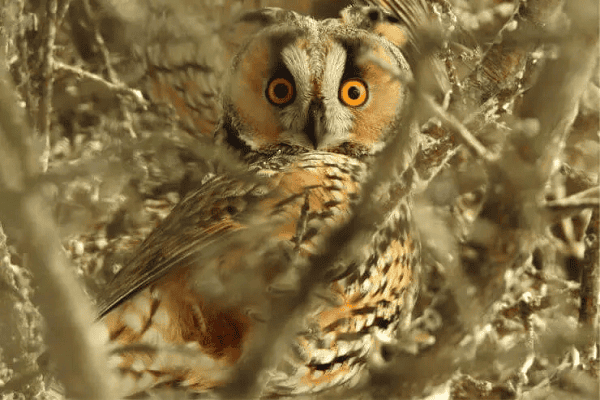
These owls are pretty smart hunters. They don’t make their own homes; they use old nests from other birds or find holes in trees. They start claiming their space with special songs and moves in March when it’s time to find a mate.
They mostly eat small animals like mice and sometimes bugs and little birds. They’re patient and can wait a long time to catch their food, or they fly low to the ground to find it.
Even though there are a lot of Long-Eared Owls, they’re having some trouble because their homes in the forest are being destroyed and they sometimes get hit by cars. But they’re still not in big danger of disappearing, and they’re even moving to new places around the world.
7. Northern Saw-whet Owl
- Scientific name: Aegolius acadicus
- Life span: 7 to 17 years
- Size: 17-22 cm
- Weight: 54-151 g
- Wingspan: 42-56.3 cm
- Status: Least Concern
The Northern Saw-Whet Owl is a tiny owl that lives all over North America, including Colorado. It’s hard to spot because it’s very secretive. This owl has a round face that’s cream with brown streaks, a dark beak, and bright yellow eyes.
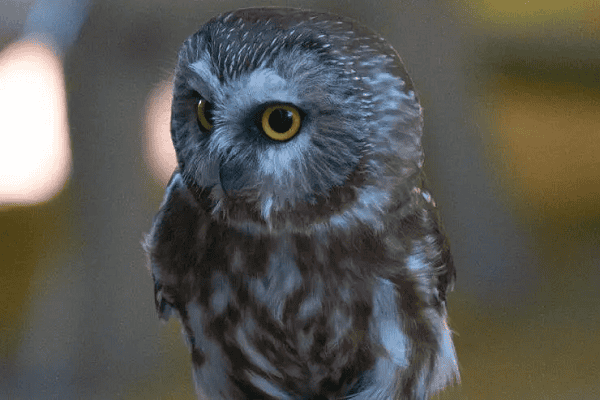
Its belly is white with light brown spots, and its back and wings are dark brown with white dots. People think it got its name because its call sounds like a saw being sharpened on a stone.
During the breeding season, which starts in March, these owls usually stick with one partner. But sometimes, if there’s a lot of food, the males might have more than one mate. They don’t make their own nests; they use holes made by other birds or boxes that people put up.
In Colorado, these owls mostly eat small animals like voles, mice, and shrews. They also eat bugs, small birds, and other little creatures. They’re really good at hunting and can catch prey in tight spaces, even ones bigger than themselves.
8. Burrowing Owl
- Scientific name: Athene cunicularia
- Life span: 6-8 years
- Size: 8-11 inches
- Weight: 5.3-8.5 oz
- Wingspan: 20-24 inches
- Status: Least Concern
The Burrowing Owl is a small, cool bird with long legs that lives in North and South America. They make their homes in holes in the ground made by animals like prairie dogs. These owls are different because they’re awake and active during the day and night.
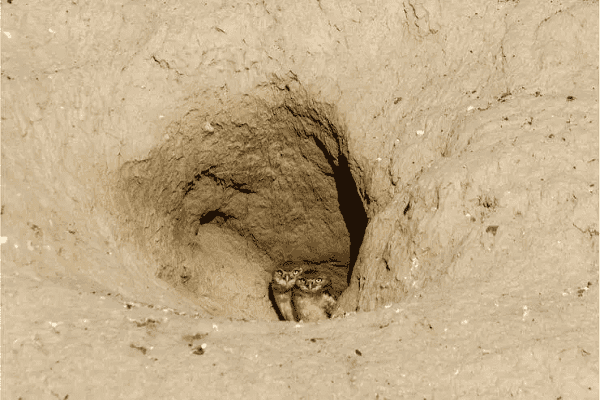
A neat thing about them is they use manure to decorate their homes to lure bugs for food.
In Colorado, Burrowing Owls dig their own homes or use old ones from other animals. These holes keep them safe from bad weather and enemies.
Also, They eat lots of different things like bugs, small animals, and reptiles. They have bright yellow eyes, and white marks above their eyes, and they make sounds like a dog’s bark.
Sadly, there are fewer Burrowing Owls now because their homes are being destroyed by people building things. But people are trying to help by making new homes for the owls, so they have a safe place to live.
Check Our Previous Articles
9. Flammulated Owl
- Scientific name: Psiloscops flammeolus
- Life span: 6-8 years
- Size: 6-7 inches
- Weight: 1.1-2.2 oz
- Wingspan: 14-17 inches
- Status: Least Concern
The Flammulated Owl is a tiny owl that lives in the thick forests of North America. It’s hard to see because it has reddish-brown feathers and dark eyes that help it hide in the trees. The name “Flammulated” means “little flame,” which fits the small, flame-like marks on its feathers.
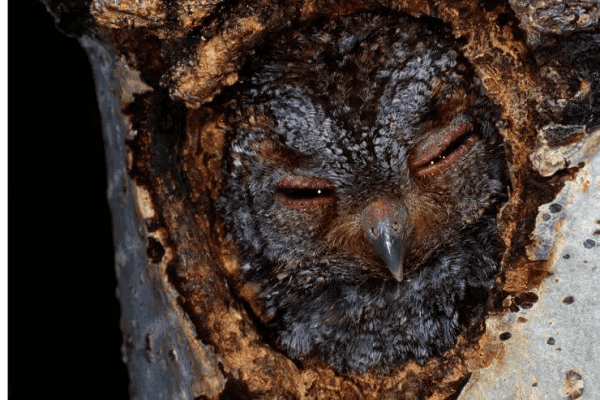
These owls have a special way of talking that sounds like a ball bouncing. They are loyal to one partner during the time they have babies, and they live in holes in trees, often using spots that woodpeckers have left behind. The mom lays 2 to 4 eggs, and both parents help keep the eggs warm for about a month. After the baby owls hatch, their parents feed them until they can fly, which takes about four weeks.
Flammulated Owls eat mostly bugs like moths, beetles, and grasshoppers, but sometimes they eat small animals and birds too. They hunt at night using their great eyesight and hearing.
10. Northern Pygmy Owl
- Scientific name: Glaucidium gnoma
- Life span: 7-10 years
- Size: 6-7 inches
- Weight: 2.1-2.5 oz
- Wingspan: 14-16 inches
- Status: Least Concern
The Northern Pygmy Owl is a tiny but mighty owl that you can find all over North America, from the cold of Alaska to the warmth of Mexico. They’re easy to recognize with their round heads, yellow eyes, and dark bills.
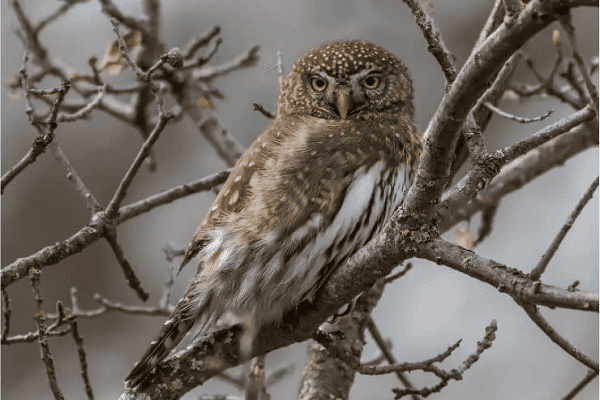
Their feathers change color based on where they live, from grey to brown and white. These little owls are tough hunters and can catch birds that are much bigger than they are, like quails and jays.
They make their homes in holes in trees or in old nests left by woodpeckers, and sometimes people put up special boxes for them to nest in. They lay between 3 and 7 eggs and take care of them for about a month until they hatch. The baby owls stay in the nest for about four weeks before they’re ready to fly on their own.
In Colorado, the Northern Pygmy Owl eats all sorts of things, like small birds, mammals, and bugs. They’re special because they hunt both in the daytime and at night, which means they’re really good at finding food.
Frequently Asked Questions
Q1. What is the most common owl in Colorado?
The most common owl in Colorado is the Great Horned Owl.
Q2. Where can I see owls in Colorado?
You can see owls in various habitats across Colorado, including forests, grasslands, and urban areas.
Q3. Do owls migrate in Colorado?
Some owl species in Colorado are migratory, such as the Northern Saw-whet Owl, but others, like the Great Horned Owl, are year-round residents.
Q4. What do Colorado owls eat?
Colorado owls typically feed on small mammals like mice, voles, rabbits, and occasionally birds, insects, and reptiles.

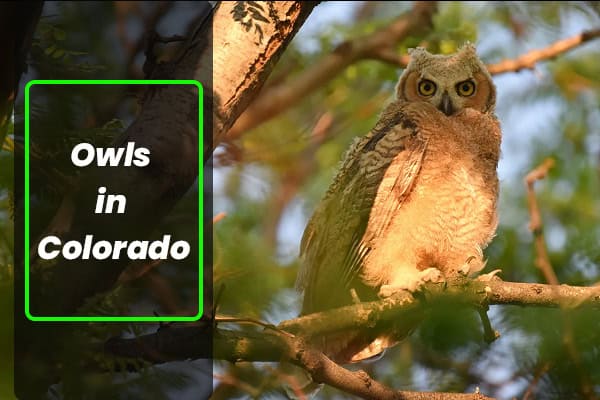

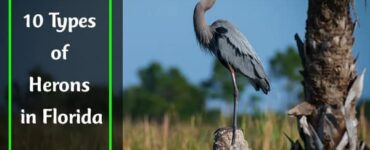
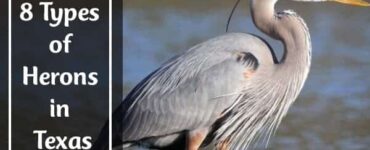
Add comment